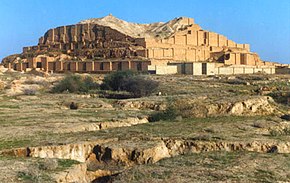Choqazanbil
| چغازنبيل (Persian) Dur Untash (Elamite) |
|

Ziggurat at Chogha Zanbil
|
|
| Location | Khuzestan Province, Iran |
|---|---|
| Coordinates | 32°0′30″N 48°31′15″E / 32.00833°N 48.52083°ECoordinates: 32°0′30″N 48°31′15″E / 32.00833°N 48.52083°E |
| Type | Settlement |
| History | |
| Builder | Untash-Napirisha |
| Founded | 1250 BC |
| Abandoned | 640 BC |
| Cultures | Elamite |
| Site notes | |
| Excavation dates | 1951–1961 |
| Archaeologists | Roman Ghirshman |
| Condition | In ruins |
| UNESCO World Heritage Site | |
| Criteria | Cultural: (iii), (iv) |
| Reference | 113 |
| Inscription | 1979 (3rd Session) |
|
[]
|
|
Chogha Zanbil (Persian: چغازنبيل; Elamite: Dur Untash) is an ancient Elamite complex in the Khuzestan province of Iran. It is one of the few existent ziggurats outside of Mesopotamia. It lies approximately 30 km (19 mi) south-east of Susa and 80 km (50 mi) north of Ahvaz.
The Elamite name of this structure is Ziggurat Dūr Untash, (/ˈzɪɡəræt/ ZIG-ər-at; from semetic Akkadian ziqqurat , D-stem of zaqāru "to build on a raised area") and Dur Untash is the combination of Elamite Dur (Place/resident/city) like Arabic "Dur/Dar" with the same meaning and Untash the Elamite king who build it, However this structure is known by Its new Persian name today "Chogha Zanbil" that has given to it Chogha in Bakhtiari means "hill". Choga Zanbil means 'basket mound.' It was built about 1250 BC by the king Untash-Napirisha, mainly to honor the great god Inshushinak. Its original name was Dur Untash, which means 'town of Untash', but it is unlikely that many people, besides priests and servants, ever lived there. The complex is protected by three concentric walls which define the main areas of the 'town'. The inner area is wholly taken up with a great ziggurat dedicated to the main god, which was built over an earlier square temple with storage rooms also built by Untash-Napirisha. The middle area holds eleven temples for lesser gods. It is believed that twenty-two temples were originally planned, but the king died before they could be finished, and his successors discontinued the building work. In the outer area are royal palaces, a funerary palace containing five subterranean royal tombs.
Although construction in the city abruptly ended after Untash-Napirisha's death, the site was not abandoned, but continued to be occupied until it was destroyed by the Assyrian king Ashurbanipal in 640 BC. Some scholars speculate, based on the large number of temples and sanctuaries at Chogha Zanbil, that Untash-Napirisha attempted to create a new religious center (possibly intended to replace Susa) which would unite the gods of both highland and lowland Elam at one site.
...
Wikipedia

